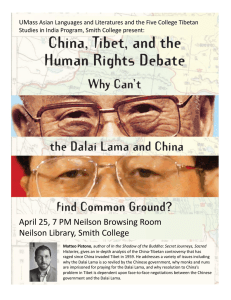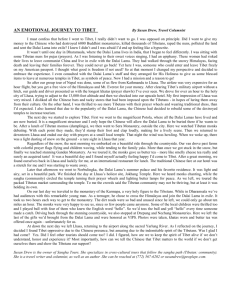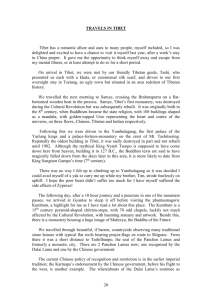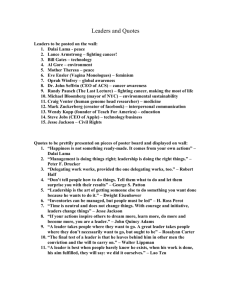Tibet: Death by consumerism Lindsey Hilsum
advertisement
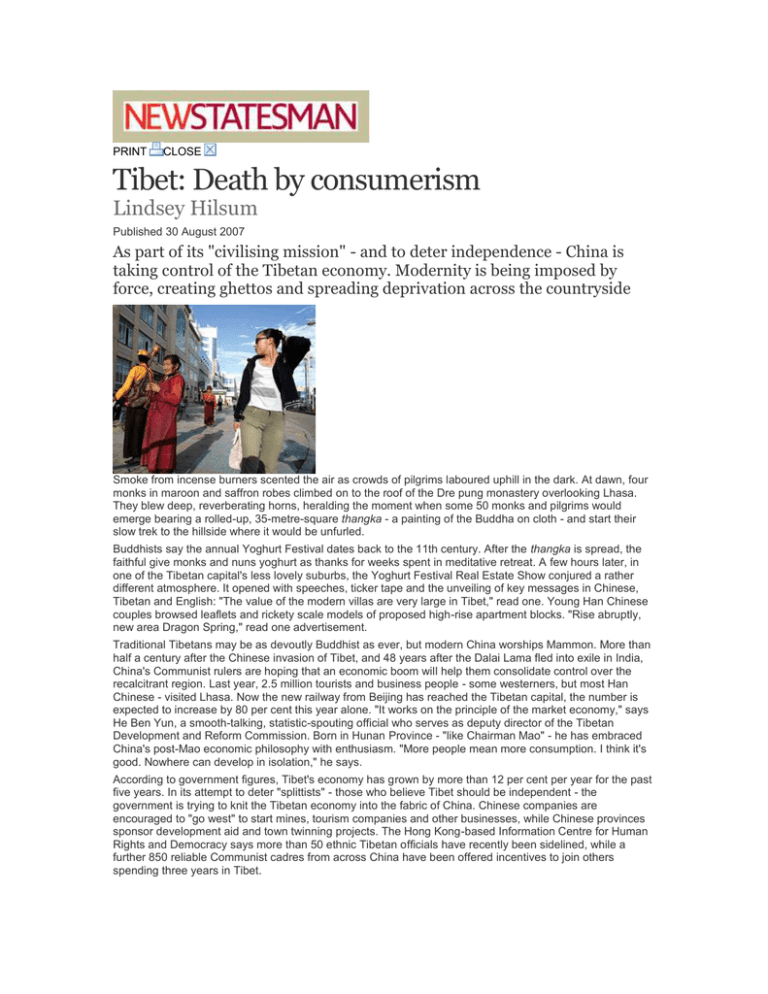
PRINT CLOSE Tibet: Death by consumerism Lindsey Hilsum Published 30 August 2007 As part of its "civilising mission" - and to deter independence - China is taking control of the Tibetan economy. Modernity is being imposed by force, creating ghettos and spreading deprivation across the countryside Smoke from incense burners scented the air as crowds of pilgrims laboured uphill in the dark. At dawn, four monks in maroon and saffron robes climbed on to the roof of the Dre pung monastery overlooking Lhasa. They blew deep, reverberating horns, heralding the moment when some 50 monks and pilgrims would emerge bearing a rolled-up, 35-metre-square thangka - a painting of the Buddha on cloth - and start their slow trek to the hillside where it would be unfurled. Buddhists say the annual Yoghurt Festival dates back to the 11th century. After the thangka is spread, the faithful give monks and nuns yoghurt as thanks for weeks spent in meditative retreat. A few hours later, in one of the Tibetan capital's less lovely suburbs, the Yoghurt Festival Real Estate Show conjured a rather different atmosphere. It opened with speeches, ticker tape and the unveiling of key messages in Chinese, Tibetan and English: "The value of the modern villas are very large in Tibet," read one. Young Han Chinese couples browsed leaflets and rickety scale models of proposed high-rise apartment blocks. "Rise abruptly, new area Dragon Spring," read one advertisement. Traditional Tibetans may be as devoutly Buddhist as ever, but modern China worships Mammon. More than half a century after the Chinese invasion of Tibet, and 48 years after the Dalai Lama fled into exile in India, China's Communist rulers are hoping that an economic boom will help them consolidate control over the recalcitrant region. Last year, 2.5 million tourists and business people - some westerners, but most Han Chinese - visited Lhasa. Now the new railway from Beijing has reached the Tibetan capital, the number is expected to increase by 80 per cent this year alone. "It works on the principle of the market economy," says He Ben Yun, a smooth-talking, statistic-spouting official who serves as deputy director of the Tibetan Development and Reform Commission. Born in Hunan Province - "like Chairman Mao" - he has embraced China's post-Mao economic philosophy with enthusiasm. "More people mean more consumption. I think it's good. Nowhere can develop in isolation," he says. According to government figures, Tibet's economy has grown by more than 12 per cent per year for the past five years. In its attempt to deter "splittists" - those who believe Tibet should be independent - the government is trying to knit the Tibetan economy into the fabric of China. Chinese companies are encouraged to "go west" to start mines, tourism companies and other businesses, while Chinese provinces sponsor development aid and town twinning projects. The Hong Kong-based Information Centre for Human Rights and Democracy says more than 50 ethnic Tibetan officials have recently been sidelined, while a further 850 reliable Communist cadres from across China have been offered incentives to join others spending three years in Tibet. At midday in the main square, in front of the Dalai Lama's traditional seat, the red and white Potala Palace, a skinny Chinese girl in evening dress was miming Chinese pop songs for an audience of imported officials and military officers. To show that this was part of the Yoghurt Festival, a huge cardboard cut-out of what looked like a cup of shaving cream had been propped up on one side of the stage. The officials in the audience sported baseball caps from Amway, an American "multilevel marketing" company. They took pictures with their mobile phones, while police kept the public well back. It's a common complaint that only the Han and other migrants, such as the Muslim Hui, are benefiting from the boom. "They take up a big part of the employment market. They settle and start their families here. Tibetans are slowly marginalised," says Woeser, a Tibetan dissident writer who was expelled from her government work unit in Lhasa for praising the Dalai Lama. (Like many Tibetans she uses just one name.) "They not only build houses and open restaurants in Tibet, but they're also taking over the traditional Tibetan industries. Tibetan food, Tibetan furniture, Tibetan costumes are all made by Han people now," she said. Such views are taboo in Tibet. Woeser's blogs have been blocked and her book, Tibetan Journal, banned. She now lives in Beijing, but still travels around provinces with Tibetan communities to gather information. When she visits her family in Lhasa, she is closely watched. Tibet is more solidly under Chinese control than ever before, yet the government remains nervous of dissenting views. While Beijing-based foreign journalists travel without supervision in most of China, the government imposes a "minder" on all correspondents visiting Tibet officially. When asked why, Mr He says it is because of the high altitude. "Our main concern is that journalists should adapt physically," he says. Journalists who try to work after entering as tourists are frequently harassed or arrested. RESETTLEMENT Tibetans are cautious about talking politics to foreigners, but - although there are still political prisoners these days the Chinese attitude tends to be more patronising than brutal. It is official policy to tolerate ethnic minorities and their religions, provided they are loyal to the party and the state. "The government pays full respect to ethnic customs," says Mr He. "Tibetan culture is an exotic flower among Chinese cultures. It has existed for more than 2,000 years. But we will help them remove bad or backward habits, and lead them to a more civilised life." As part of its civilising mission, and to integrate Tibetans into the modern economy, the government has resettled 25,000 nomadic and farming families into "new socialist villages". The plan is to settle 80 per cent of rural Tibetans in the next five years. The countryside is being transformed, with small enclaves of white houses, many flying the red flag, along the roads. An hour's drive north of Lhasa, 260 families have been resettled in the village of Sangbasa. The railway runs past the new houses, each guarded by a ferocious, chained dog. There is no doubt that these houses are an improvement on the huts and tents in which nomadic herders used to stay, nor that settlements make it easier for older people to get medical help and children to go to school. Huang Qian Min, a half-Han half- Tibetan official, explained that it should be possible for Tibetans to continue their traditions while living in improved conditions. "They can live in the settlements in winter and herd animals in summer. Then they can go on herding and enjoy the modern life at the same time," she said. Asked whether the programme was designed so the party can control Tibetans better, she said such an idea was ridiculous. "When they were scattered they knew very little about the world. Through TV and radio, they become more knowledgeable and make more progress. By living together, they can exchange ideas and improve themselves," she said. TV and radio are controlled by the Chinese government; only those with access to the internet or shortwave can hear alternative views. Suo Nang Zhuo Ma's grandchildren were herding yaks in front of her new house, which boasted glass windows and a comfortable sofa, as well as a television. At 58, she looked 20 years older, and appeared to have little nostalgia for the harsh life she had led, tending livestock and bringing up six children. "With help from the Communist Party of China, we have started a happier life, without many worries," she said. But those who have had to give up the nomadic life altogether are struggling. The train runs over the Tanggula Pass to Qinghai Province, which has a substantial Tibetan minority. Concerned that overgrazing is damaging the fragile grasslands, the government has instructed several thousand Tibet an nomads to sell their herds and move to newly built suburbs on the outskirts of Golmud, a bleak mining town. The result is ghettos - more than a hundred years on, the process of deprivation and deracination experienced by Aborigines in Australia and Native Americans in the US is being repeated high on the Tibetan plateau. Young men play pool at tables laid out along the street, or kick a ball around the dusty wasteland. Each family is given a house and the equivalent of £70 a month in welfare. "In the beginning, the Tibetan nomads are excited that the government is giving them free money to live in the cities, so they sign up to move, looking forward to living like the people they see on TV," says Woeser. "At first, they have money from selling their animals plus money given by the government, but over time, their money is used up. They learn to spend money like city people but they don't have the skills to make money like city people." POWER OF RELIGION Most of the former herders are enthusiastic about education, but frequently Tibetan children - who may have never been to school before - are in classes of younger children, learning in Mandarin, which is not their native language. They face discrimination, often being seen as backward or stupid. Outside school, they have little interaction with non-Tibetan children, and are rapidly becoming an underclass. While the men start to drink, the women increasingly turn to religion. One afternoon in mid-August, dozens of Tibetans, mostly women dressed in traditional clothes, packed into a small room in a Qinghai town to hear a visiting lama. For more than four hours, they spun their prayer-wheels and chanted, as children scurried in and out. On a table at the front, carefully concealed behind Coke bottles, biscuits and a vase of plastic flowers, was a portrait of the Dalai Lama. Showing such images is banned, because the Chinese government demands that its citizens be loyal only to the party. Yet some children sported medallions bearing the Dalai Lama's image and a 25-year-old former herder had created a shrine in his house, including a photo of one of his relatives posing with the Dalai Lama in Dharamsala, where the Tibetan government-inexile has its headquarters. "The Dalai Lama is not only a religious, but also a national leader," says Woeser. "His international influence makes Tibetans proud. They like to prove that they're not like the Communist propaganda, which says they're backward and dirty." Jealous of the power of religion, the Chinese government announced in August that lamas must have official permission to reincarnate - a directive which may prove a little hard to implement. The real target is the Dalai Lama, who is now 72. The Chinese hope that when he dies, all thoughts of independence will die with him, but they fear a repetition of the furore over the reincarnation of the second most holy figure in Tibetan Buddhism, the Panchen Lama. When the 10th Panchen Lama died in 1989, the Chinese government not only dictated who should succeed him, but "disappeared" the boy identified by the Dalai Lama as the true reincarnation. He is still missing. In early August, Runggye Adak, an ethnic Tibetan, leapt on stage at an annual horse festival in Sichuan and shouted that the Dalai Lama should return, the imprisoned Panchen Lama should be released and Tibet should have independence. He is now in Chinese custody. At this summer's horse fairs, thousands of Tibetans eschewed their traditional ceremonial fur garments after the Dalai Lama said killing animals for fur was bad. The government allegedly threatened to penalise civil servants who did not wear fur to the festivals, seeing it as an indication that they were following the Dalai Lama. As the sun rose above Lhasa, shafts of light fell across the grassy hill where a grid had been placed so the giant Yoghurt Festival thangka could be spread. As Sakyamuni, the Buddha, was slowly revealed, a great sigh of joy rose from the crowd. Monks and pilgrims threw white silk scarves known as hadas on to the image in a gesture of reverence. The momentum towards modernity in Tibet is unstoppable. Physically, the Chinese Communist Party can dictate where people live and how they are governed. It can bring in millions of tourists and business people. But, after half a century, it still cannot control what Tibetans believe. Lindsey Hilsum is China correspondent for Channel 4 News Tibet timeline 1904 British troops occupy Lhasa. China declares sovereignty over Tibet 1907 Britain and Russia recognise China's right to Tibet 1910 Chinese troops enter Lhasa. The 13th Dalai Lama flees to India 1912 Tibetan militias force Chinese to withdraw. Dalai Lama returns 1920s, 1930s, 1940s China distracted by civil war and Second Sino-Japanese War 1950 Communist troops invade eastern Tibet. Next year, China annexes Tibet 1959 Lhasa rebels; 87,000 Tibetans killed. The 14th Dalai Lama flees to India Mid-1960s 6,000 Tibetan monasteries destroyed during Chinese "cultural revolution" 1976 China campaigns to settle ethnic Chinese in Tibet 1979 Tibet opens to foreign tourists 1989 Dalai Lama is awarded Nobel Peace Prize 1990s to present China consolidates hold on Tibet
